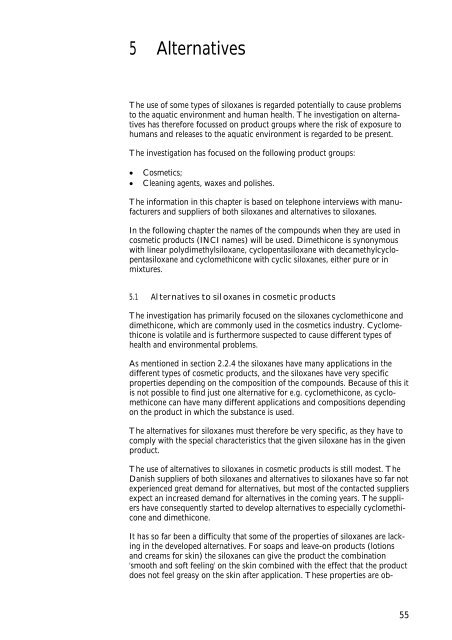No. 1031 - Miljøstyrelsen
No. 1031 - Miljøstyrelsen
No. 1031 - Miljøstyrelsen
You also want an ePaper? Increase the reach of your titles
YUMPU automatically turns print PDFs into web optimized ePapers that Google loves.
5 Alternatives<br />
The use of some types of siloxanes is regarded potentially to cause problems<br />
to the aquatic environment and human health. The investigation on alternatives<br />
has therefore focussed on product groups where the risk of exposure to<br />
humans and releases to the aquatic environment is regarded to be present.<br />
The investigation has focused on the following product groups:<br />
• Cosmetics;<br />
• Cleaning agents, waxes and polishes.<br />
The information in this chapter is based on telephone interviews with manufacturers<br />
and suppliers of both siloxanes and alternatives to siloxanes.<br />
In the following chapter the names of the compounds when they are used in<br />
cosmetic products (INCI names) will be used. Dimethicone is synonymous<br />
with linear polydimethylsiloxane, cyclopentasiloxane with decamethylcyclopentasiloxane<br />
and cyclomethicone with cyclic siloxanes, either pure or in<br />
mixtures.<br />
5.1 Alternatives to siloxanes in cosmetic products<br />
The investigation has primarily focused on the siloxanes cyclomethicone and<br />
dimethicone, which are commonly used in the cosmetics industry. Cyclomethicone<br />
is volatile and is furthermore suspected to cause different types of<br />
health and environmental problems.<br />
As mentioned in section 2.2.4 the siloxanes have many applications in the<br />
different types of cosmetic products, and the siloxanes have very specific<br />
properties depending on the composition of the compounds. Because of this it<br />
is not possible to find just one alternative for e.g. cyclomethicone, as cyclomethicone<br />
can have many different applications and compositions depending<br />
on the product in which the substance is used.<br />
The alternatives for siloxanes must therefore be very specific, as they have to<br />
comply with the special characteristics that the given siloxane has in the given<br />
product.<br />
The use of alternatives to siloxanes in cosmetic products is still modest. The<br />
Danish suppliers of both siloxanes and alternatives to siloxanes have so far not<br />
experienced great demand for alternatives, but most of the contacted suppliers<br />
expect an increased demand for alternatives in the coming years. The suppliers<br />
have consequently started to develop alternatives to especially cyclomethicone<br />
and dimethicone.<br />
It has so far been a difficulty that some of the properties of siloxanes are lacking<br />
in the developed alternatives. For soaps and leave-on products (lotions<br />
and creams for skin) the siloxanes can give the product the combination<br />
'smooth and soft feeling' on the skin combined with the effect that the product<br />
does not feel greasy on the skin after application. These properties are ob-<br />
55

















